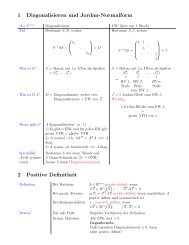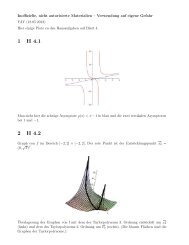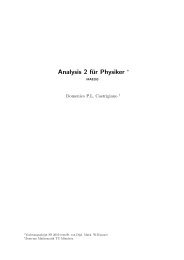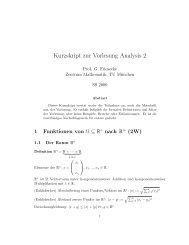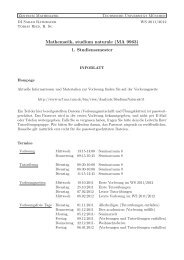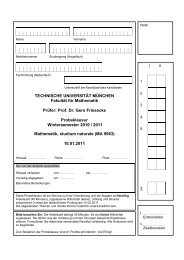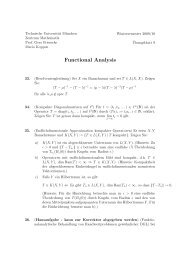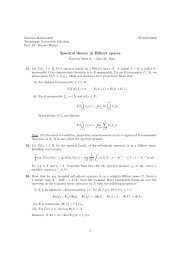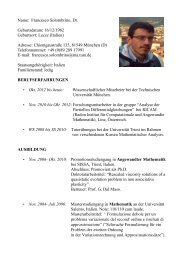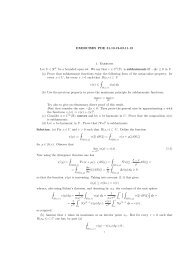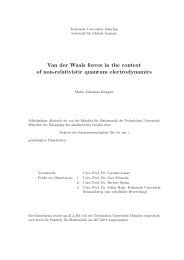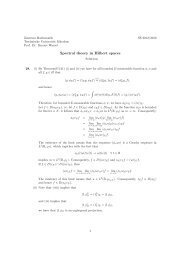EXERCISES PDE 23-25.01.13 1. Exercise Fourier analysis in ...
EXERCISES PDE 23-25.01.13 1. Exercise Fourier analysis in ...
EXERCISES PDE 23-25.01.13 1. Exercise Fourier analysis in ...
You also want an ePaper? Increase the reach of your titles
YUMPU automatically turns print PDFs into web optimized ePapers that Google loves.
EX11 3therefore (2.1) is equivalent to prove that2(B(u N , u N ) − B(u, u N ) + B(u, v N ) − B(u N , v N )) = 0 .This can be easily proved to be true by observ<strong>in</strong>g that by def<strong>in</strong>ition of u and u N , for every v N ∈ H None hasB(u, v N ) = F (v N ) = B(u N , v N )and <strong>in</strong> particular, for v N = u N ,B(u, u N ) = B(u N , u N ) .Now, by (2.1), and the coercivity and cont<strong>in</strong>uity of B we get for every v N ∈ H Nc 0 ‖u − u N ‖ 2 H ≤ B(u − u N, u − u N ) ≤ B(u − u N , u − u N ) + B(v N − u N , v N − u N ) =B(u − v N , u − v N ) ≤ C 1 ‖u − v N ‖ 2 Hwhence√C‖u − u N ‖ H ≤ 1c 0‖u − v N ‖ Hfor every v N ∈ H N . Tak<strong>in</strong>g the <strong>in</strong>fimum <strong>in</strong> the rigth-hand side gives (2.2).(d) To prove existence of u and u N when B is given by (2.3), it suffices to check that the Lax-Milgram theorem can be applied. The only relevant po<strong>in</strong>t to this end is to prove coercivity of B ,which follows from the Po<strong>in</strong>caré <strong>in</strong>equality. Namely, one hasB(u, u) ≥ ‖u ′ ‖ 2 2 ≥ 11 + π 2 ‖u‖2 H . 1It follows now from the previous exercise that<strong>in</strong>f{‖u − v N ‖ H 10 ((0,π)) : v N ∈ H N } → 0as N goes to +∞. In particular, by (<strong>1.</strong>1), if u ∈ H 2 one has for every N ∈ N<strong>in</strong>f{‖u − v N ‖ H 10 ((0,π)) : v N ∈ H N } ≤ C N ‖u‖ H 2 .Comb<strong>in</strong><strong>in</strong>g these two facts with (2.2) gives the conclusion.□3. <strong>Exercise</strong>Consider a bounded smooth open subset Ω ⊂ R N , and Γ D ⊂ ∂Ω with H N−1 (Γ D ) > 0. LetH 1 Γ D(Ω) := {u ∈ H 1 (Ω), T u = 0 on Γ D } ,with T the trace operator. For λ > 0 def<strong>in</strong>eˆB λ (u, v) = ∇u(x) · ∇v(x) dx − 1 ˆT u(ξ) T v(ξ) dH N−1 (ξ)Ω λ ∂Ωfor u and v ∈ HΓ 1 D(Ω). Prove that, when λ is sufficiently large, for every f ∈ L 2 (Ω) there exists aunique u f ∈ HΓ 1 D(Ω) such thatˆB λ (u f , v) = f(x) v(x) dxfor every v ∈ H 1 Γ D(Ω). H<strong>in</strong>t: does the Po<strong>in</strong>caré <strong>in</strong>equality apply <strong>in</strong> H 1 Γ D(Ω)?Solution: Follow<strong>in</strong>g the h<strong>in</strong>t, let us first prove that there exists a constant C such thatΩ‖u‖ L2 (Ω) ≤ C‖∇u‖ L2 (Ω) (3.1)for every u ∈ HΓ 1 D(Ω). To prove this, it suffices to argue as <strong>in</strong> the proof of the Po<strong>in</strong>caré-Wirt<strong>in</strong>ger<strong>in</strong>equality (Theorem 1, Section 5.8.1 <strong>in</strong> Evans’book): contradict<strong>in</strong>g (3.1) would produce the existenceof a sequence u n <strong>in</strong> HΓ 1 D(Ω) with ‖u n ‖| L2 (Ω) = 1 for every n which is converg<strong>in</strong>g to a constant c <strong>in</strong>H 1 (Ω). By cont<strong>in</strong>uity of the trace operator, HΓ 1 D(Ω) is a Hilbert subspace of H 1 (Ω), so it must bec = 0, s<strong>in</strong>ce this one is the only constant <strong>in</strong> HΓ 1 D(Ω). On the other hand, by strong L 2 convergencewe must have ‖c‖ L 2 (Ω) = c|Ω| 1 2 = 1, and this gives a contradiction.



